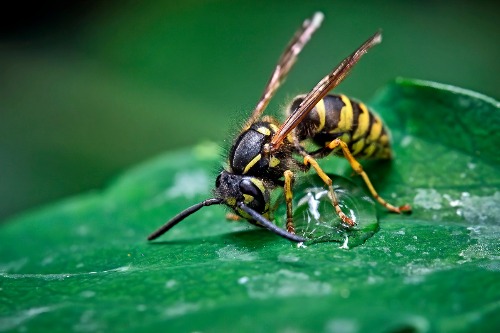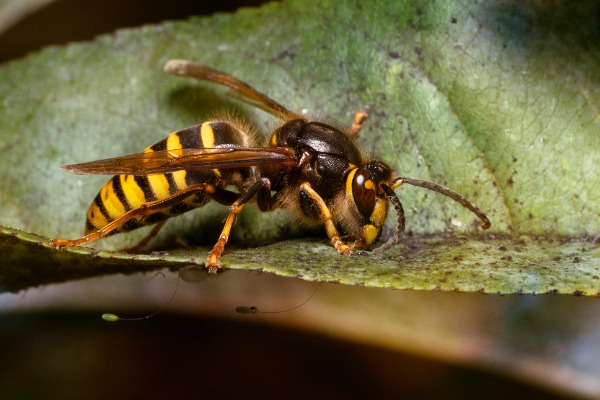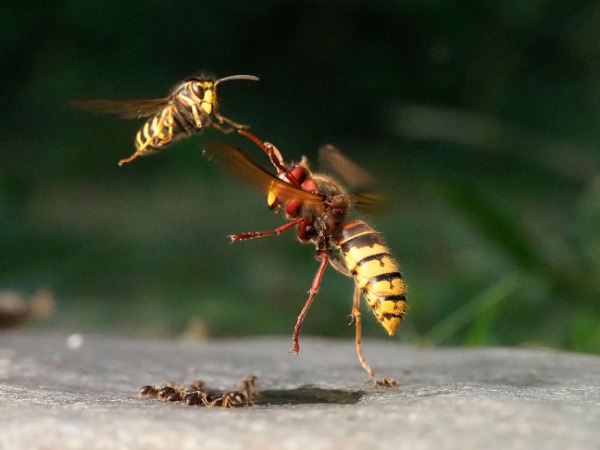Frequently Asked Questions About Yellowjackets
What's the difference between a wasp and a yellowjacket? Are yellowjackets found in Britain and are they all black and yellow?
Here we'll clear up some of the confusion about yellowjacket wasps.
Yellowjacket FAQs
What is the difference between a wasp and a yellow jacket?
The word 'wasp' is an umbrella term, which covers a vast variety of stinging and non-stinging, slim-waisted insects within the order 'Hymenoptera', and the suborder Apocrita, which they share with bees and ants.
The term 'yellowjacket' is actually an American expression.
A yellowjacket wasp is any wasp which belongs to either one of two genera:
- the Vespula genus, or
- the Dolichovespula genus1.
Are yellowjacket wasps in the UK?
The term 'yellowjacket' is not commonly used in the UK.
However, the UK has a number of species belonging to each of the Vespula and Dolichovespula genera that could colloquially be labelled 'yellowjacket'.
British "yellowjacket" species
 Common Wasp - Vespula vulgaris
Common Wasp - Vespula vulgarisExamples of British species belonging to the Vespula and Dolichovespula genera2:
Vespula:
Vespula rufa - Red Wasp
Vespula austriaca - Austrian Cuckoo Wasp
Vespula vulgaris - Common Wasp
Vespula germanica - German Wasp
Dolichovespula:
Dolichovespula sylvestris - Tree Wasp
Dolichovespula norwegica - Norwegian Wasp
Dolichovespula saxonica - Waxon Wasp
Dolichovespula media - Median Wasp.
 Median Wasp, Dolichovespula media
Median Wasp, Dolichovespula mediaAre yellowjacket species always yellow and black?
In Britain, all yellowjacket species are yellow and black.
However, in the USA, despite the name, the Baldfaced Hornet is in fact a black and white wasp belonging in the yellowjacket category.
Do yellowjacket wasps sting? How bad is a yellowjacket sting?
Yes, yellowjackets can sting and can be defensive of nests.
However, despite general perceptions, yellowjacket stings are no worse than the stings of many other stinging insects.
According to research, in a comparison of sting pain where the score was 1 for least painful, and 4 for most painful, the yellow jacket species were allocated the score of 2.
See: Bee vs Wasp vs Hornet Stings for further information.
However, no doubt repeated stings from multiple wasps could be painful!
See advice for deterring wasps and preventing stings if you are concerned.
Are yellowjacket stings the same as bee stings?
The venoms of bees, wasps and hornet stings are chemically different, and have varying toxicity levels.
Honey bee venom may be slightly more acidic than the venom of some wasp species.
What is the difference between yellowjacket wasps and other wasps and hornets?
 A yellowjacket species (left - possibly Vespula vulgaris) is warned off a food source by a larger European Hornet, Vespa crabro (right).
A yellowjacket species (left - possibly Vespula vulgaris) is warned off a food source by a larger European Hornet, Vespa crabro (right).- Yellowjackets inhabit social nests (including the parasite cuckoo, Vespula austriaca - the Austrian Cuckoo Wasp which attacks the nests of social Vespula species2), where as many wasp species are solitary.
As is the case with eusocial bee species, yellowjacket colonies feature many workers serving the colony and rearing the offspring of a queen.
- Wasp species vary hugely in the type of cavities and nests they use to rear offspring (for example, as is the case with gall wasps and potter wasps).
All yellowjackets nests are 'paper nests' typically made from bark, plant or wood shavings, and consisting of many hexagonal-shaped egg cells.
Yellowjacket nests may be found in cavities (underground or elevated) or aerial nests (for example, hanging from tree branches). - Yellowjackets are medium-sized wasps (typically measuring 12 - 18mm in Britain2).
Hornets are large wasps. In Britain, the species Vespa crabro measures 15 - 30mm2.
References
1. Reed, Hal C. and Peter Landolt. “Ants, Wasps, and Bees (Hymenoptera).” Medical and Veterinary Entomology (2019): n. pag.
2. Brock, Paul D: Britain's Insects - A Field Guide To The Insects Of Great Britain And Ireland Princeton University Press WILDguides Ltd, 2021, ISBN: 9780691179278.
3. Eric R. Heaton; Insectpedia. A Brief Compendium Of Insect Lore. Princeton University Press 2022.
If you found this page helpful or interesting, I'd really be grateful if you would share it with others - if not this page, perhaps another, such as Gardening For Bees.
Thank you so much :) .